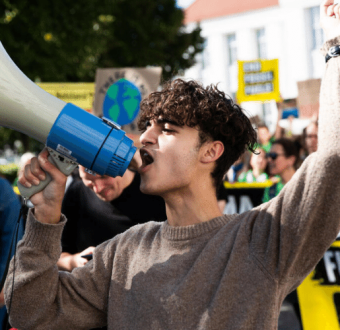Perhaps it goes without saying, but It’s hard to capture and keep people’s attention these days.
If these were ordinary times — which they’re not — it would be difficult enough to inspire people when we’re already feeling oversaturated by media of all forms. Add to that the events leading up to and including the election of Donald Trump, and we watched as a new political rhetoric quickly chipped away at what seemed “normal”, finding ourselves relentlessly inundated by news of irrational, horrifying, and absolutely insane circumstances on a daily basis.
What message can possibly stick within such turmoil?
There are moments in history where an image comes along and captures a mood so succinctly. And while what is witnessed can resonate differently amongst each of us, it nevertheless has the power to unify those collective feelings around a common cause.
In the days following the inauguration of Donald Trump, faced with a new reality of what was to become an unprecedented assault on the environment, we saw millions of people ready to fight back against attacks to our climate and our communities. So on a cold, January morning in Washington D.C., seven activists scaled a crane to drop one simple, yet powerful message of solidarity: RESIST. Within minutes, the image— a hand-painted pledge hovering next to the White House — was seen around the world, helping to galvanizing an atmosphere of resistance. We were promising to resist and resist often, standing with all those who were translating their fears into action.
We asked three of the activists there that day — Nancy Hernandez, Malachi Robinson, and Karen Topakian — what it was like to be a part of this incredible moment, and how they saw a year of resistance play out in their own communities.
It’s been a year since the Resist protest happened near the White House — that must have been an incredible experience, and it certainly took real guts to do it. Can you describe how you felt leading up to and including the moment the banner unfurled over the D.C. skyline that morning? Could you hear and see what was happening on the ground?
Nancy Hernandez: So it’s January 2018, and the government has shut down. I’m thinking back to a year ago when I was getting into a van at 3 am, wearing a hardhat and harness, and preparing to climb a crane above the White House. We listened to Biggie Smalls en route.
The calm before the banner dropped felt like hope for an uprising that would shift the future course of our lives. We waited for the sun to rise to deploy a message that I thought would serve as a hand-painted love letter to the people, and an unwelcome mat to the guy occupying the oval office.
Malachi Robinson: The only thing I was thinking about while climbing was to get up as fast as possible before anyone sees us — just getting there as fast as possible. Right when I looked down and saw the traffic and police back up around the city, I thought ‘wow, this is really intense, what am I doing?!’
I could see what was happening on the ground and as soon as we dropped the banner, people started cheering. I also has a cell phone and went online and saw that the moment was trending everywhere, so I made a post that said, ‘this is me currently’ and all my friends thought I was lying. I had to take a selfie to prove that it was me up there.
Karen Topakian: It was a mix of complete and utter panic and being terrified. It is well known amongst my friends that I have morbid fear of heights — so I was terrified and exhilarated by the opportunity. My fear of Trump, what he said he would do and what he had already done, that is what propelled me up the 100-foot frame. Once I was safe and in place, I felt comfortable looking down…slightly. At that point, then I thought ‘oh my f*cking word, we did it. We’re not going anywhere, they’re not messing with us.’ In the distance, you could see police everywhere on the ground, news trucks and cameras, and the crowds started to form with people looking up.
What motivated you to join this protest and did you have experience in direct actions prior to this?
NH: I began taking direct action in high school when California’s then governor was attempting to exclude undocumented people from schools, social services, and healthcare. I realized that marches feel good to us, but that to make real systemic change, we must do more than stand within authorized lines.
MR: I’ve always been drawn to social justice and advocacy work, even as a child I remember going to Reparation Now meetings in the 90s. My parents used to work for African Services, an organization which worked with refugees. When you see someone with my background — my dad was deported when I was 4, and my mom’s dad was deported when she was a child — as a Black, Queer, both first and second-generation immigrant, it really informed my identity.
I also did work with different non-profits and eventually began with Greenpeace as a canvasser. I even started an action camp called TWAC (Trans and/or Women’s Action Camp) and the first one we did in the Bay Area. We wanted to give people who are typically not in the direct action community opportunities to get those skills.

Karen Topakian has been arrested over 30 times for participating in direct action and non-violent protest. She is seen here in the 1980’s, during a rally against nuclear arms build-up between the U.S. and Russia.
KT: What motivated me was the threat of Trump’s campaign promises and his already enacted executive orders — reinstating the Keystone XL pipeline, threats to the LGBT community, talking about instituting immigration reform (which soon became the Muslim ban) and the threat to our planet and democracy. I will say I have a lot of experience in direct action and blockades but never in climbing. I have a history of civil disobedience since 1982, predominantly in against nuclear weapons and war, and protection of the earth.
What do you think this protest accomplished?
NH: Unlike some people, I don’t like to brag about being the ‘biglyest’ or best, but I do think this action was one of the most viewed across the globe to date. The evolution in communications have increased the impacts of direct actions. The livestream and interviews had millions of views and shares online and articles were written about it in each continent on the planet.
MR: Well, I think that it really made the word ‘RESIST’ go viral.
It was a rallying cry within the first couple days of the Trump Administration — with the Muslim ban being a few days after that — it was a way to fight back and it spoke to how people were feeling. It gave hope, it made people’s day better and it made them feel like they could get out and do something.
We will. @Greenpeace @greenpeaceusa pic.twitter.com/Tyz1R3aIpK
— Minnie Driver (@driverminnie) January 25, 2017
If you look at the amount of people who joined up with Greenpeace after that, it was a lot. I did a ‘RESIST’ action training over the summer, workshops in both the Bay Area and NYC, and there were hundreds of people who signed up. It activated something in people not only here, but all around the world.
KT: When I went into it, I didn’t have any expectations for how it would resonate or how it would be felt or experienced by people. What it did do was provide people with hope, and the knowledge that they were not alone in their fear, anxiety and anger. It resonated beyond the U.S. and beyond the environmental community— it spoke to oppression and the liberation from it. It gave a sense that there is a way and a voice to fight back. It gave the boost and solidarity to respond, keep going and endure.

Office workers take pictures and make phone calls as they watch Greenpeace activists deploy a banner on a construction crane near the White House reading “RESIST” on President Trump’s fifth day in office.
Did this have an influence on how you participated in other forms of resistance or changed how you approached activism in 2017?
MR: It didn’t change my approach to activism, but it did make me hyper aware of the usage of the word ‘resist’ — like hearing Hillary Clinton use it in reference to herself, I’m like, ‘no you’re not.’ I feel like it’s been co-opted by Democrats, who I believe created the conditions that gave us Trump.
KT: Yes and no. I’ve been doing this for 36 years and I would be lying if I said it didn’t give me a boost and renewed energy to keep going, but didn’t change how I do things. What it did was reinforce the importance and value in non-violent direct action. The simple act of raising a sign, if the words and the symbol are right, it gives a strong message. I’m so grateful that Greenpeace chose ONE word that would resonate with every struggle each person had.
When you hear or see the word “RESIST” now, what does that mean to you?
NH: Right now, when I hear the word ‘RESIST’, I think of the art that has been created in elementary, middle and high school classrooms expressing discontent with injustice. Teachers have shown the banner drop video, skyped or invited me into classrooms to talk to thousands of young minds. They have used our act of defiance as an example of how to speak out against tyranny in a nonviolent way.
MR: When I see it now I think, ‘ha! I did that!’ That’s what I think about it. And I think about how cold it was — wow, it was freezing. It was a crazy thing to do, but I did because a friend asked me to. I said yes to ‘climbing Trump’.
KT: I feel a tremendous amount personal pride, which I try to keep to myself. I implore myself to remain humble about it. When Trump made reference sometime after about ‘all these people are resisting’, I thought, ‘we got to you.’ It’s not just to support my brothers and sisters in this fight, but that it also got to Trump.
In the past year, what have you seen as the greatest threat our society faces moving forward?

Events in Charlottesville VA showed how far we will need to go to eradicate hate, bigotry, white supremacy in the United States.
NH: Every day that #45 is allowed to remain in office, our environment and communities are at risk. Every day this year, the news has pumped the fear of war, sexual assault, climate chaos, and ICE raids into our ears. But the biggest threat I see in front of me is the complacency and acceptance of the failure in our democratic system.
MR: I see lots of threats. But the rise of fascism, not only in this country but around the world is a pretty huge threat — nationalism, xenophobia, racism, chauvinism — they all come with it too. What I’m seeing is that extremism is becoming normalized. Far right-wing ideologies now seem normal, and people with progressive views are seen as ‘extreme’. Trump’s rhetoric is not ok either. It’s all of these things.
KT: I see it as Trump’s continued presidency and his administration — the whole clown car of people involved — and their continued attempts to thwart our democratic institutions, rescind environmental protections and erode our human rights.

Several of the #resist climbers at the Greenpeace office, albeit with a slightly smaller banner this time.
Anything else you’d like to add?
KT: In my obituary, I hope this action is put front and center.



